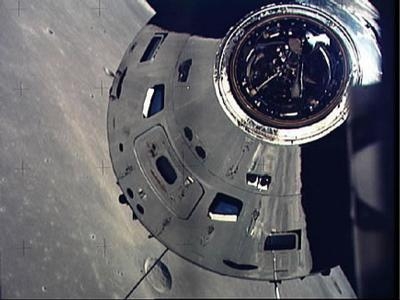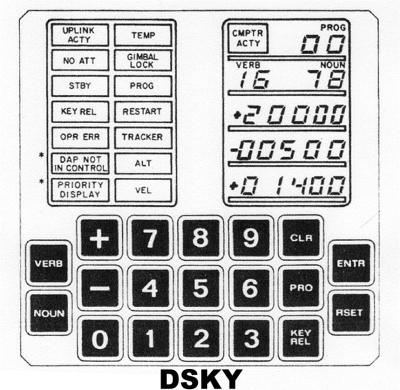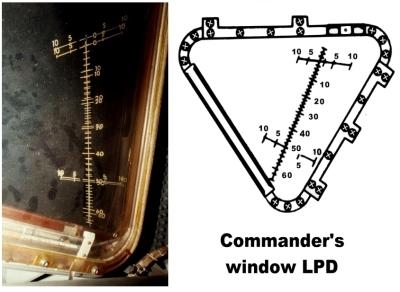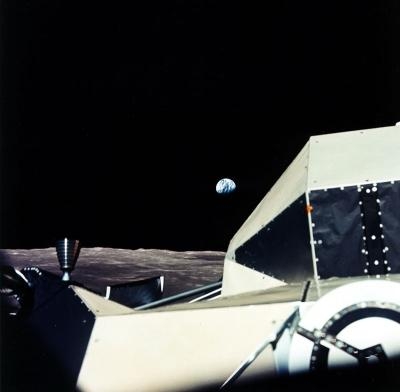Part 2: Standby For Touchdown
By: Wes Oleszewski
Captured by lunar gravity, Apollo 17 sped behind the moon. Gone, however, was the public concern that had existed when Apollo’s 8, 10 and 11 entered the same phase of their trips to the moon. Now the American public, in general, considered a flight to the moon as being “routine,” and about as interesting as a chemistry class. NASA, apparently, had done too good of a job of making it look easy. As Apollo 17 crossed behind the moon at 2:36 pm on Sunday, December 10th, 1972, it was isolated from any communication or assistance from the ground. Yet, the three major television networks did not even bother to break into regular programming to broadcast the event.

I had skipped a day of ice skating at the Civic Center just in case there may be some coverage of the lunar orbit insertion. Of course that meant that I was relegated to sitting in front of our family’s TV set frantically spinning the dial and changing the three channels between an old movie, coverage of some European ski-jumping event and a show with some political talking-heads discussing what the next four years of the Nixon administration may mean to China. The clock ticked past 2:48 when the burn was scheduled to take place and still there was nothing on my TV- so I resorted to the radio. The top of the hour news had nothing to say other than what I already knew was happening; Apollo 17 was behind the moon. An hour later, however, the radio news reported that Apollo 17 was in lunar orbit, in just about that many words. That was it- the sum total of coverage for this critical event. At best, it was a good day to sit home and mess around with my rocket models.
Monday, December 11th was one of my “Apollo Days” off from school. Once again my parents had balanced my watching historic events live on TV against what the public school system had to offer. The choice was a day with Apollo, NASA and the space program as opposed to a day of classroom disturbances, fights, small change robbery and other assorted mayhem. If you’ve never attended a public school on the wrong side of town, you probably can’t understand my parent’s wisdom, if however, you have done so you can easily understand why Apollo 17 won that one hands down. I got up and turned on “The Today Show” to check on Apollo 17 and the status for landing. The news was good with NBC reporting that their coverage would begin at 2:20 pm which was fine with me considering that the LEM was supposed to touch down a 2:54. Landing a LEM was probably the most complex and unique activity in human history. It required coordination between both of the astronauts, onboard landing
radar, ground radar from earth and the computer aboard the LEM. Certainly, a junior high school kid like me, sitting in front of the family TV set in mid-Michigan had nothing to do with it. No matter; I had my tape recorder and my books as well as my 1/144 scale Revell model and I was going to be ready for the adventure.

Once undocked, the Command Service Module (CSM), that on Apollo 17 had been named “America,” altered into a circular orbit and away from the LEM, which had been named “Challenger.” The first step in what was called “powered descent” was a 7.5 second retro-grade burn of the reaction control system (RCS) motors for ullage. The term “ullage” comes from the brewing industry and originally was the moniker given to the area left in a container when some of the contents had been drained. It is said to have been applied to rocketry by the folks at Marshall Space Flight Center in Huntsville, Alabama in the early days of the Saturn rocket program. In spaceflight then term relates to the settling of liquids in a fuel or oxidizer tank. Thus, when the onboard computer calculated the proper time… the LEM’s RCS fired ullage preparing for P63 and PDI… as they used to say in NASA moon-talk.
Flying along on their back, or rather- standing on the wall- the astronauts were looking up, away from the lunar surface as shortly after ullage the computer indicated program “63.” under the "PROG." tag. This was the program that commanded the ignition of the LEM’s descent engine. P63 was indicated on the display keyboard or “DSKY” (pronounced; dis-key) and “99” was also flashing on the display. The flashing of “99” was the computer’s way of saying that it was waiting for an astronaut input, or as Jim Lovell said, “…it asks, are you sure you really wanna do that?” Schmitt pushed “PROCEED” on the DSKY and the computer fired up the engine right on time; the crew now had Power Descent Initiation, or “PDI.”

This was actually one of a very few times that Schmitt made the actual entries into the computer. He and Cernan had worked out a method where the commander would make almost all of the entries during powered descent. This was because of Cernan’s Apollo 10 experience where he and his Commander, Tom Stafford, had some trouble because one guy had put something the computer and the other had put something in on top of it. This time they had a clear plan and a simple rule- Cernan did the entering with exception of P63 and P64 which Schmitt would do because Cernan’s attention needed to be outside at those times. Schmitt was thus dedicated to the abort guidance computer and landing radar. At PDI the LEM was orbiting at an altitude of only 56,544 feet above the moon at a velocity of 5,568 feet per second. Just 26 seconds later the descent engine throttled up to full power and the Challenger began breaking toward the surface of the moon. The astronauts could still not see much of the lunar surface
as they remained looking almost straight up. What they could see, however, was a grand view of the blue earth.
“You’re allowed two quick looks out the window,” Cernan quipped to Schmitt , whose job it was to have his head in the cockpit reading the instruments and computer DSKY, “…one now and one when we pitch over.”
“I can’t see a thing except the earth.” Schmitt replied helplessly.
“That’s what I’m tellin’ ya’ to look at.” Cernan replied with a hint of fun.
For seven minutes the engine ran at full power and then throttled down- the LEM was at just over 25,000 feet in altitude with a velocity now of only about 1,200 feet per second. For the next two minutes the LEM would continue on a gentle downward arc. The next key point in the powered descent was what the NASA press kits called “High Gate.” The news commentators really took a hold on that term and apparently loved to say it. The funny part was that the astronauts rarely, if ever, used that term. Normally they called it “pitch-over,” or “the pitch,” or “P64,” but I have yet to find a recording or transcript where they referred to it as “high gate.” Just prior to nine minutes and 20 seconds into the powered descent, the DSKY would display “P64” and flash “99.” Shortly after passing through 9,000 feet above the surface, Cernan called for the “Pro.” Schmitt hit the Proceed on the DSKY and the LEM pitched over from
a 60 degree nose high attitude to a 20 degree nose high; they were in nearly a landing attitude. Now Cernan could clearly see landmarks and known craters.
“And there it is Houston! There’s Camelot!” Cernan sang out, “Right on target!”
“I see it!” Schmitt chimed in, taking his second and last allowed look out the window during the descent.

Now Schmitt began dutifully calling out the LPD numbers. LPD was an acronym used for “Landing Point Designator.” This critical and very handy little system was one of the lynch-pins to the Apollo astronauts being able to actually land safely on the lunar surface. The computer used radar plus calculations of forward velocity and vertical velocity to calculate a forward point where its math said the LEM would touch down. It translated that data into a number that was then displayed on the DSKY. That number was then read aloud by Schmitt to Cernan who had a scale engraved into his window. He simply matched the number said to him to whatever point on the lunar surface was seen to correspond to it and he had his expected landing point. Every Apollo lunar landing used this system to line up its approach. The numbers were spoken either as simple digits, “three nine, four zero,” etc. or they were spoken in degrees, “thirty seven degrees.” That was dependent upon how the
specific crew decided to do it. On Apollo 15 for example, Jim Irwin gave Dave Scott the LPD in simple digits. On Apollo 17, Jack Schmitt gave Gene Cernan the LPD in degrees. Generally, the commander stopped using the LPD somewhere below 1,000 feet. Cernan had Schmitt stop giving LPD at about 800 feet.
Watching the simulation and animation on TV it felt as if you were watching the real thing, but it also caused you to listen very closely to those two voices talking from the moon. On all six of the lunar landings it always struck me deep down that those men were flying to a landing ON THE MOON! Hovering in to a location where no human had ever been. They were a quarter of a million miles away. Most importantly, one tiny malfunction could set off a chain events that would likely kill them- as we listened. They were alone in the most hostile environment that humans had ever ventured into. It was the most gripping experience that anyone could ever witness. What puzzled me, however, was why was it only gripping to so few Americans such as myself? Why wasn’t every American, every human, in any civilized place glued to this event like I was? It is a question that to this day still bewilders me.
Cernan and Schmitt made their calls, followed their radar and soon the Challenger’s four legs and their rod-like landing probes were stretching out toward the powdery surface of the moon.

“Standby for touchdown.” Cernan flatly reported. It was a remark that he could have patented. He used it on ever space shuttle landing that he helped broadcast a decade later… only a few of us noticed, I’ll bet.
As the probes touched the surface a blue light went on in front of Schmitt, “Contact,” He sung out and then, by reflex and training, he went directly into calling out the landing checklist, “Stop, push! Engine stop! Engine Arm, Proceed, Command Override, Off, Mode Control, Att. Hold, Pings- Auto.”
“Okay Houston, the Challenger has landed!” Cernan exclaimed proudly.
Houston Capcom Gordon Fullerton came back with a subdued “Okay, that’s super.” You’d have thought that he had just finished a landing simulation he was so professionally unemotional.
Of course the pressure was not off- there was still the probability of something going wrong, in which case the crew would have to abort and liftoff immediately in order to rendezvous with the CSM. One thing a pilot learns, either by training- or by accident, is that just when you think you are home free and you have got it made- that is when the worst tends to happen. So, they had to now safe the LEM and get it configured for liftoff while Mission Control looked at all of the systems and decided if they could stay on the lunar surface. After the longest three minutes and 46 seconds of their lives, Cernan and Schmitt were given a “Go” to stay from Mission Control. Humanity’s last landing on the moon, perhaps in our lifetime, was a success.
Looking over at my 1/144 scale Revell Lunar Module model, I could clearly see that it too had landed safely on our living room carpet, for about the 4,000th time.
(Images provided by NASA)
 ANN's Daily Aero-Linx (04.13.24)
ANN's Daily Aero-Linx (04.13.24) ANN's Daily Aero-Term (04.13.24): Beyond Visual Line Of Sight (BVLOS)
ANN's Daily Aero-Term (04.13.24): Beyond Visual Line Of Sight (BVLOS) Airborne 04.09.24: SnF24!, Piper-DeltaHawk!, Fisher Update, Junkers
Airborne 04.09.24: SnF24!, Piper-DeltaHawk!, Fisher Update, Junkers Aero-News: Quote of the Day (04.14.24)
Aero-News: Quote of the Day (04.14.24) ANN's Daily Aero-Term (04.14.24): Maximum Authorized Altitude
ANN's Daily Aero-Term (04.14.24): Maximum Authorized Altitude







